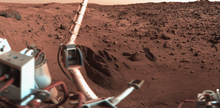Kasutaja:Jaanus.kalde/liivakast
Elu otsing
[muuda | muuda lähteteksti]
The current understanding of planetary habitability—the ability of a world to develop environmental conditions favorable to the emergence of life—favors planets that have liquid water on their surface.
This most often requires that the orbit of a planet lie within the habitable zone, which for the Sun extends from just beyond Venus to about the semi-major axis of Mars.[1] During perihelion, Mars dips inside this region, but the planet's thin (low-pressure) atmosphere prevents liquid water from existing over large regions for extended periods. The past flow of liquid water demonstrates the planet's potential for habitability. Some recent evidence has suggested that any water on the Martian surface may have been too salty and acidic to support regular terrestrial life.[2]
The lack of a magnetosphere and extremely thin atmosphere of Mars are a challenge: the planet has little heat transfer across its surface, poor insulation against bombardment of the solar wind and insufficient atmospheric pressure to retain water in a liquid form (water instead sublimes to a gaseous state). Mars is also nearly, or perhaps totally, geologically dead; the end of volcanic activity has apparently stopped the recycling of chemicals and minerals between the surface and interior of the planet.[3]

Evidence suggests that the planet was once significantly more habitable than it is today, but whether living organisms ever existed there remains unknown. The Viking probes of the mid-1970s carried experiments designed to detect microorganisms in Martian soil at their respective landing sites and had positive results, including a temporary increase of CO2 production on exposure to water and nutrients. This sign of life was later disputed by some scientists, resulting in a continuing debate, with NASA scientist Gilbert Levin asserting that Viking may have found life. A re-analysis of the Viking data, in light of modern knowledge of extremophile forms of life, has suggested that the Viking tests were not sophisticated enough to detect these forms of life. The tests could even have killed a (hypothetical) life form.[4] Tests conducted by the Phoenix Mars lander have shown that the soil has a alkaline pH and it contains magnesium, sodium, potassium and chloride.[5] The soil nutrients may be able to support life, but life would still have to be shielded from the intense ultraviolet light.[6] A recent analysis of martian meteorite EETA79001 found 0.6 ppm ClO4−, 1.4 ppm ClO3−, and 16 ppm NO3−, most likely of martian origin. The ClO3− suggests presence of other highly oxidizing oxychlorines such as ClO2− or ClO, produced both by UV oxidation of Cl and X-ray radiolysis of ClO4−. Thus only highly refractory and/or well-protected (sub-surface) organics or life forms are likely to survive.[7] In addition, recent analysis of the Phoenix WCL showed that the Ca(ClO4)2 in the Phoenix soil has not interacted with liquid water of any form, perhaps for as long as 600 Myr. If it had, the highly soluble Ca(ClO4)2 in contact with liquid water would have formed only CaSO4. This suggests a severely arid environment, with minimal or no liquid water interaction.[8]

Some scientists have proposed that carbonate globules found in meteorite ALH84001, which is thought to have originated from Mars, could be fossilized microbes extant on Mars when the meteorite was blasted from the Martian surface by a meteor strike some 15 million years ago. This proposal has been met with skepticism, and an exclusively inorganic origin for the shapes has also been proposed.[10]
Small quantities of methane and formaldehyde detected by Mars orbiters are both claimed to be possible evidence for life, as these chemical compounds would quickly break down in the Martian atmosphere.[11][12] Alternatively, these compounds may instead be replenished by volcanic or other geological means, such as serpentinization.[13]
Impact glass, formed by the impact of meteors, which on Earth can preserve signs of life, has been found on the surface of the impact craters on Mars.[14][15] Likewise, the glass in impact craters on Mars could have preserved some signs of life if life existed at the site.[16][17][18]
Programmeerimiskeelte navmall
[muuda | muuda lähteteksti]Pooleli. Jätka.
- ↑ Viitamistõrge: Vigane
<ref>-silt. Viide nimegaNowackon ilma tekstita. - ↑ Viitamistõrge: Vigane
<ref>-silt. Viide nimegasaltlifeon ilma tekstita. - ↑ Viitamistõrge: Vigane
<ref>-silt. Viide nimegahannsson97on ilma tekstita. - ↑ Viitamistõrge: Vigane
<ref>-silt. Viide nimegaphysorg070107on ilma tekstita. - ↑ Viitamistõrge: Vigane
<ref>-silt. Viide nimeganutrienton ilma tekstita. - ↑ Viitamistõrge: Vigane
<ref>-silt. Viide nimegaUVon ilma tekstita. - ↑ Kounaves, S. P. et al., Evidence of martian perchlorate, chlorate, and nitrate in Mars meteorite EETA79001: implications for oxidants and organics, Icarus, 2014, 229, 206–213, DOI:10.1016/j.icarus.2013.11.012,
- ↑ Kounaves, S. P.; et al. (2014). ", Identification of the perchlorate parent salts at the Phoenix Mars landing site and implications". Icarus. 232: 226–231. Bibcode:2014Icar..232..226K. DOI:10.1016/j.icarus.2014.01.016.
{{cite journal}}: et al.-i üleliigne kasutus kohas:|last2=(juhend) - ↑ Staff (8. juuni 2015). "PIA19673: Spectral Signals Indicating Impact Glass on Mars". NASA. Vaadatud 8. juunil 2015.
- ↑ Viitamistõrge: Vigane
<ref>-silt. Viide nimegaam89on ilma tekstita. - ↑ Viitamistõrge: Vigane
<ref>-silt. Viide nimegaicarus172on ilma tekstita. - ↑ Viitamistõrge: Vigane
<ref>-silt. Viide nimegaformon ilma tekstita. - ↑ Viitamistõrge: Vigane
<ref>-silt. Viide nimegaolivineon ilma tekstita. - ↑ Nickel, Mark (18. aprill 2014). "Impact glass stores biodata for millions of years". Brown University. Vaadatud 9. juunil 2015.
- ↑ Schultz, P. H.; Harris, R. Scott; Clemett, S. J.; Thomas-Keprta, K. L.; Zárate, M. (juuni 2014). "Preserved flora and organics in impact melt breccias". Geology. 42 (6): 515–518. Bibcode:2014Geo....42..515S. DOI:10.1130/G35343.1.
- ↑ Brown, Dwayne; Webster, Guy; Stacey, Kevin (8. juuni 2015). "NASA Spacecraft Detects Impact Glass on Surface of Mars". NASA. Vaadatud 9. juunil 2015.
- ↑ Stacey, Kevin (8. juuni 2015). "Martian glass: Window into possible past life?". Brown University. Vaadatud 9. juunil 2015.
- ↑ Temming, Maria (12. juuni 2015). "Exotic Glass Could Help Unravel Mysteries of Mars". Scientific American. Vaadatud 15. juunil 2015.
